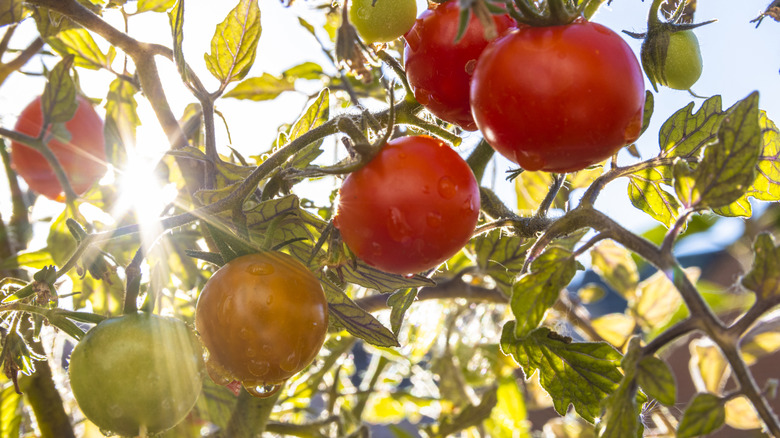Why Your Garden Tomatoes Taste So Sour (And What To Do About It)
Experiencing puckering sourness while sinking your teeth into a plump red homegrown tomato can leave even the most optimistic gardeners disappointed. After all, all the deep nurturing was supposed to leave the tomato fruits sweet and juicy, not tart and unpleasant. While genetic makeup and variety type can explain the acidic sensation, there are plenty of other causes for your red fruits tasting sour. Premature harvesting or unfavorable growing conditions, such as inadequate sun exposure and deficient watering practices, can sap your pomodoro of its juiciness.
However, all hope isn't lost just because your current fruit set turned out sour. Switching out your existing tomato plant for sweeter varieties and optimizing growth conditions should do the trick. Extending your tomato plant's ripening period by planting early and harvesting it after it matures fully should improve its sweetness levels. However, steer clear of the sugar hack and avoid adding sugar to your plant's soil to turn your garden tomatoes less sour.
Reasons for sour tasting tomatoes
Tart tomatoes are usually a consequence of excessively acidic components, a feature of the plant's variety. For instance, Green Zebra, Brandywine, and Stupice are known to have high acidic content, making them taste unpleasant. Even color plays a key role, with orange and yellow varieties tasting sweeter than their vibrant red counterparts. Further, your ruby treasures may not taste fruity if exposed to environmental and growth stressors.
Excessive sunlight and high temperatures — exceeding 92 degrees Fahrenheit — during the plant growth stage will also cause the fruit to turn yellow and sour. Similarly, overwatering your tomato plant can strip the soil of all the requisite nutrients, inhibiting adequate growth and flavor development. As tomatoes prefer acidic soils with pH levels between 6 and 6.8, any significant variation can affect nutrient intake, resulting in them tasting sharp. Flavors are also impacted when these plants are prevented from maturing on the vine and harvested prematurely, denying them the chance to develop natural sugars.
Ways to make tomatoes taste sweeter
Luckily, there are several ways to help your tomato plants grow tastier fruits. Choosing a more balanced variety that suits your climatic conditions is an easy way to improve the taste. For example, heirloom tomato varieties like Seattle's Best of All are more tolerant of wet climates. Similarly, varieties such as Sakura, Sun Sugar, and Rosada work better for those looking for sweeter tomatoes.
However, if the plant's type is not an issue, optimizing growth conditions can help. Your tomatoes must receive at least eight hours of sunlight and be given adequate vine growth opportunities for protection against intense heat. This also improves foliage growth, enabling your red gems to convert more carbs into sugars, leaving them flavorful. Be sure to prune your plants regularly and space them optimally (at least 20 inches apart) for better results. Any soil issues can be dealt with by amending the soil with organic compost and reducing nitrogen applications. Applying potassium and phosphorus during the ripening stage also helps improve sugar content. Finally, halve the watering amount when the fruit matures to allow flavor saturation and harvest before it turns soft.


